Keep your smoked meats fresh longer by maintaining your refrigerator temperature at 40°F or below. You'll want to vacuum seal portions whenever possible and wrap meats in multiple protective layers using plastic wrap, foil, or freezer bags. Store items on the bottom shelf to prevent cross-contamination, and always label packages with smoking and storage dates. Don't forget to monitor storage time limits – 3-4 days for non-vacuum sealed meats in the fridge, and up to 12 months when frozen. Use airtight containers, control humidity levels, and follow proper thawing techniques when needed. These fundamentals are just the beginning of mastering smoked meat preservation.
Maintain Optimal Refrigeration Temperature
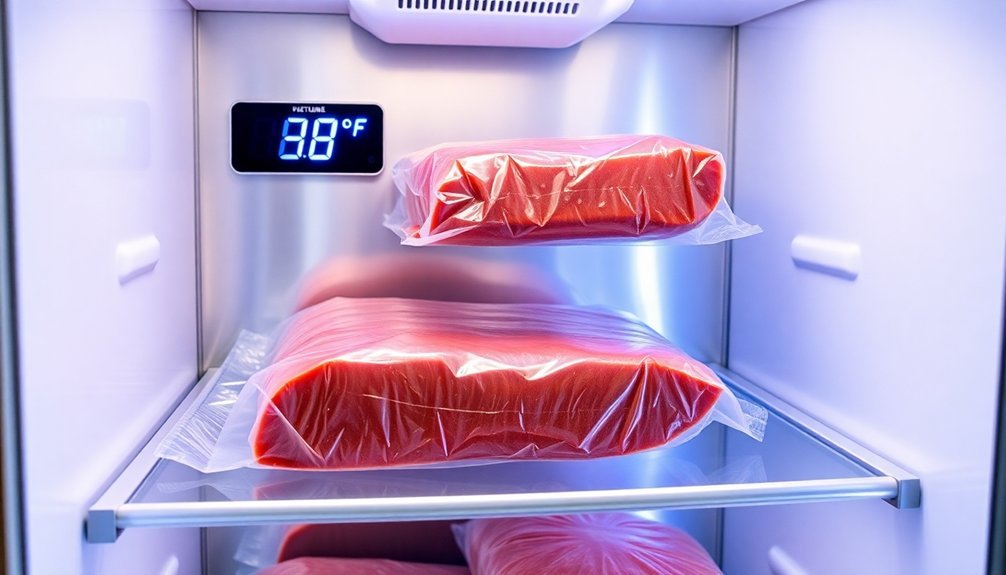
When storing smoked meats, maintaining the right refrigerator temperature is vital for food safety and quality. You'll want to set your refrigerator temperature at 40°F (4°C) or below to slow down bacterial growth while preserving the meat's texture and flavor.
The ideal temperature range falls between 34°F and 40°F (1°C to 4°C), providing the perfect environment for food storage. Vacuum-sealed packages can help maintain optimal temperatures by creating an airtight barrier around your meats.
Don't rely on your refrigerator's built-in settings alone. Install a reliable thermometer to monitor the actual temperature inside your fridge. You should check this thermometer regularly to guarantee your smoked meats stay within the safe temperature zone.
If you notice any fluctuations outside the recommended range, adjust your refrigerator settings immediately.
Remember that temperature consistency is important. Keep your refrigerator door closed as much as possible to maintain stable temperatures, and don't place your fridge near heat sources or in direct sunlight.
When you're storing multiple items, make sure they're not packed too tightly, as this can prevent proper air circulation and create warm spots.
Master Vacuum Sealing Techniques
A proper vacuum sealing technique can dramatically extend the shelf life of your smoked meats while preserving their rich flavors and tender textures. To achieve the best results, you'll need to pre-freeze your meats for 1-2 hours before sealing, which prevents texture issues and locks in essential juices. Unlike traditional aluminum foil wrapping that risks leaks and moisture loss, vacuum-sealed storage provides superior protection.
| Process Step | What You Need to Do | Time Required |
|---|---|---|
| Pre-freezing | Place meat on tray in freezer | 1-2 hours |
| Portioning | Cut into meal-sized sections | 10-15 minutes |
| Sealing | Remove air and seal completely | 2-3 minutes |
When you're ready to reheat your vacuum-sealed smoked meats, use a simmering water bath at 190°F. You'll want to avoid rapid boiling, as a gentle simmer for 15-25 minutes (depending on weight) is sufficient to reach safe serving temperatures of 155-165°F. Choose a vacuum sealer with features that match your needs, such as adjustable seal times and bag cutters. You'll also need high-quality vacuum bags in various sizes to accommodate different meat portions. By properly vacuum sealing your smoked meats, you can extend their freezer life up to 3 years while maintaining their quality and reducing food waste.
Proper Wrapping Before Storage
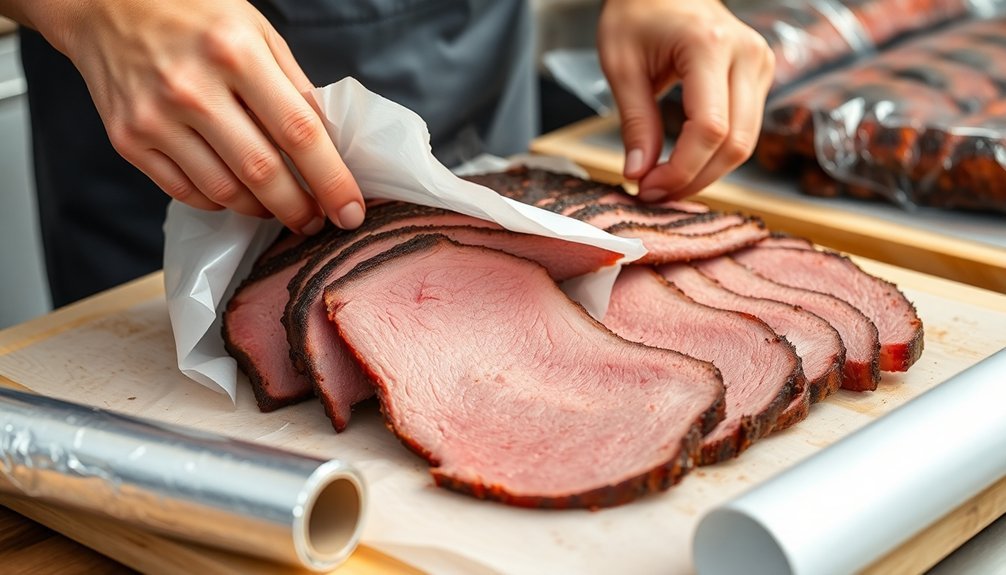
To protect your smoked meats from spoilage, you'll need to wrap them in multiple protective layers using either plastic wrap, aluminum foil, or freezer-safe bags.
You must guarantee each layer is tightly wrapped with no air pockets to prevent moisture from accumulating during storage.
When using plastic wrap or freezer bags, press out all air and create an airtight seal before adding an outer layer of foil for maximum protection.
Proper storage using these methods can help your smoked meats maintain quality for up to 3 months in the freezer.
Air-Tight Wrapping Methods
Proper air-tight wrapping stands as your first line of defense in preserving smoked meats' quality and flavor. You've got several effective methods to choose from, each with its unique benefits for maintaining freshness.
| Method | Best Used For | Key Benefits |
|---|---|---|
| Vacuum-Sealing | Long-term storage | Extends shelf life up to 1 year in freezer |
| Butcher Paper | Maintaining bark | Allows smoke penetration while keeping moisture |
| Aluminum Foil | Quick storage | Traps heat and moisture effectively |
For the best results with vacuum-sealing, you'll want to confirm complete air removal before sealing. If you don't have a vacuum sealer, you can use airtight containers as an alternative, but make sure they're completely sealed. When using butcher paper, wrap your meat tightly and consider spraying it with water or apple cider to enhance moisture retention. If you're opting for aluminum foil, remember it'll stop the smoking process, so time this method carefully to avoid affecting your meat's bark texture. Don't forget to label your wrapped meats with dates and contents – this simple step will help you track storage times and maintain food safety standards.
Multiple Layer Protection
Building up layers of protection when wrapping smoked meats can make the difference between preserving flavor and losing it.
You'll want to start with a double layer of butcher paper on the bottom, which provides vital breathability while maintaining moisture control. This unbleached material not only protects your meat but also breaks down naturally within weeks.
When applying multiple layers, position fatty cuts with the fat side up and poultry with the skin side up. You'll need to wrap tightly, making sure each layer is secure before adding the next. The fold-and-roll technique helps create an effective seal that locks in the meat's natural juices while still allowing proper smoke penetration.
Time your layering process carefully. Don't wrap too early – wait until you've reached the stall stage or when the internal temperature hits around 150°F. This guarantees you've developed a proper smoke ring first.
Your multiple layers will help combat evaporation during the remainder of the cooking process and through the vital resting period. The result is tender, flavorful meat with a protected bark that doesn't turn soggy, thanks to the breathable layers regulating steam and moisture.
Prevent Moisture Accumulation
While multiple layers protect your meat during smoking, success in long-term storage depends on managing moisture accumulation. You'll need to carefully wrap your smoked meats before storing them to prevent both moisture loss and unwanted condensation.
Start by letting your meat rest properly after smoking, allowing it to cool slightly while retaining its essential juices.
When you're ready to store your meat, wrap it tightly in butcher paper rather than aluminum foil. The paper's porous nature lets the meat breathe while preventing excess moisture from building up, which could lead to bacterial growth. Make sure you've sealed all edges thoroughly to create an effective barrier against external moisture.
Don't store your meat until it's reached a safe temperature below 40°F to avoid the dangerous bacterial growth zone. You'll want to place your wrapped meat in a controlled environment, like your refrigerator, where the temperature remains stable.
If you notice any condensation forming inside the wrapping, replace it immediately with fresh paper. Remember to check your stored meat regularly for any signs of excess moisture, which could indicate it's time to adjust your storage method or use the meat soon.
Bottom Shelf Storage Strategy
Storing smoked meats on your refrigerator's bottom shelf isn't just a space-saving strategy – it's a critical food safety practice. When you place smoked meats on lower shelves, you'll prevent their juices from dripping onto other foods, which greatly reduces the risk of cross-contamination. This is especially important since raw meats can contain harmful bacteria that shouldn't come into contact with ready-to-eat items.
You'll want to keep your refrigerator temperature at 41°F or below to maintain the meat's freshness and prevent bacterial growth. Store your smoked meats in airtight containers or sealed bags to protect them from absorbing other food odors and flavors.
Don't forget to label each package with the date you stored it to help track freshness and guarantee proper rotation.
As you organize your bottom shelf, avoid overcrowding to allow proper air circulation. Make sure there's enough space between containers, and don't stack them too tightly.
If you notice any meat developing sliminess, strange odors, or discoloration, it's time to discard it, as these are clear signs of spoilage.
Monitor Storage Time Limits
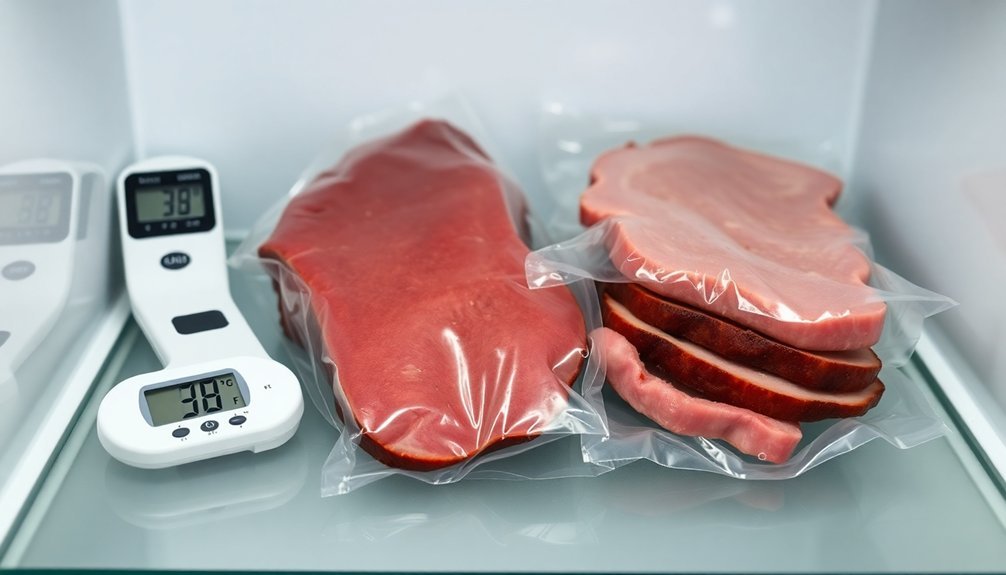
To maximize the shelf life of your smoked meats, you'll need to carefully track how long they've been stored. Refrigerate your smoked meats within 2 hours of removing them from the smoker, and keep them at 40°F (4°C) or below to slow bacterial growth. Without vacuum sealing, your refrigerated smoked meats will last 3-4 days.
| Meat Type | Refrigerator Life | Freezer Life |
|---|---|---|
| Beef | 3-4 days | 3 months |
| Pork | 4-5 days | 3 months |
| Poultry | 2-3 days | 3 months |
| Any (Vacuum Sealed) | 4-5 days | 6-12 months |
For extended storage, freeze your smoked meats immediately. They'll keep for up to 3 months when properly wrapped, or 6-12 months if vacuum sealed. Don't refreeze thawed meats, as this can compromise food safety. When you're ready to use frozen smoked meat, thaw it in the refrigerator for 24 hours.
Watch for signs of spoilage like sliminess, discoloration, or foul odors. Always label your storage containers with contents and dates to track freshness accurately. If you're using vacuum-sealed bags, remove as much air as possible before sealing to prevent premature spoilage.
Cold Smoking Temperature Control
You'll need to maintain cold smoking temperatures below 90°F (32°C) to prevent accidentally cooking your meat while smoking it.
Your smoker setup should include accurate thermometers to monitor both the smoking chamber and the meat's internal temperature, helping you stay within the safe range.
Using equipment like pellet tube generators and external fireboxes with proper ventilation will give you better control over the smoke and temperature throughout the process.
Ideal Temperature Range Settings
The ideal temperature range for cold smoking requires careful attention to maintain superior conditions between 68°F and 86°F (20°C to 30°C).
You'll want to keep your temperatures consistently within this range to guarantee proper smoke penetration without accidentally cooking your meat. If you exceed 86°F, you risk cooking the food instead of achieving the desired smoke flavor.
To maintain these precise temperatures, you'll need to monitor your smoker regularly and make adjustments as needed. You can use ice blocks in your smoke chamber to help stabilize temperatures, and proper ventilation is vital for controlling both temperature and preventing bacterial growth.
Remember that you're working within a sensitive range – staying below 90°F is essential to prevent bacterial proliferation.
Different foods may require slight temperature variations within this range. For example, when you're smoking fermented sausages, you'll want to aim for temperatures below 72°F (22°C).
For fattier cuts, you'll need to be especially vigilant with temperature control to prevent the meat from becoming greasy. Leaner cuts might need different settings to avoid over-smoking, so you should adjust your temperature based on the specific food you're smoking.
Equipment for Temperature Monitoring
Maintaining precise cold smoking temperatures requires reliable monitoring equipment. You'll need a combination of tools to guarantee your smoked meats stay at ideal temperatures throughout the process. Pellet tube smoke generators offer consistent smoke production while minimizing creosote buildup, making them ideal for cold smoking applications.
| Equipment Type | Key Benefits |
|---|---|
| Automatic Controllers | Controls oxygen flow with digital precision; connects to mobile devices |
| Remote Thermometers | Monitors temps up to 300 feet away; 1,800-hour battery life |
| Cold Smoke Adaptors | Maintains temps 3-18° above ambient; variable speed control |
You'll want to invest in an automatic temperature controller that regulates airflow to maintain steady conditions. These controllers connect to your smoker's intake and use fans to moderate oxygen flow, preventing unwanted temperature fluctuations. For precise monitoring, wireless thermometer systems let you track both meat and pit temperatures from a distance, with dual-channel probes and programmable alarms. If you're focusing on cold smoking, custom adaptor systems with ice chambers and variable speed air pumps will help you maintain lower temperatures while controlling smoke output effectively.
Maintaining Consistent Cold Smoke
Successfully controlling cold smoke temperatures requires careful attention to three critical ranges. You'll need to keep your smoking chamber below 86°F to achieve proper cold smoking, while strictly avoiding the danger zone between 40°F and 140°F where bacteria thrive.
The ambient room temperature should stay between 68°F and 86°F for ideal results.
To maintain these temperatures, you'll want to set up your smoking chamber with proper ventilation and temperature control features. Place ice blocks inside the chamber and use an external firebox to generate smoke without adding excess heat.
A pellet tube smoke generator can provide consistent smoke while minimizing temperature fluctuations.
You can improve temperature control by installing a dryer tube to remove creosote and adding vents to regulate smoke flow. Monitor your setup closely to prevent temperatures from exceeding 90°F, which would start cooking the meat instead of cold smoking it.
Remember to cure your meat beforehand to extract moisture and create an environment hostile to bacterial growth. Once you've finished smoking, refrigerate your meat immediately to maintain its freshness and safety.
Safe Thawing Practices
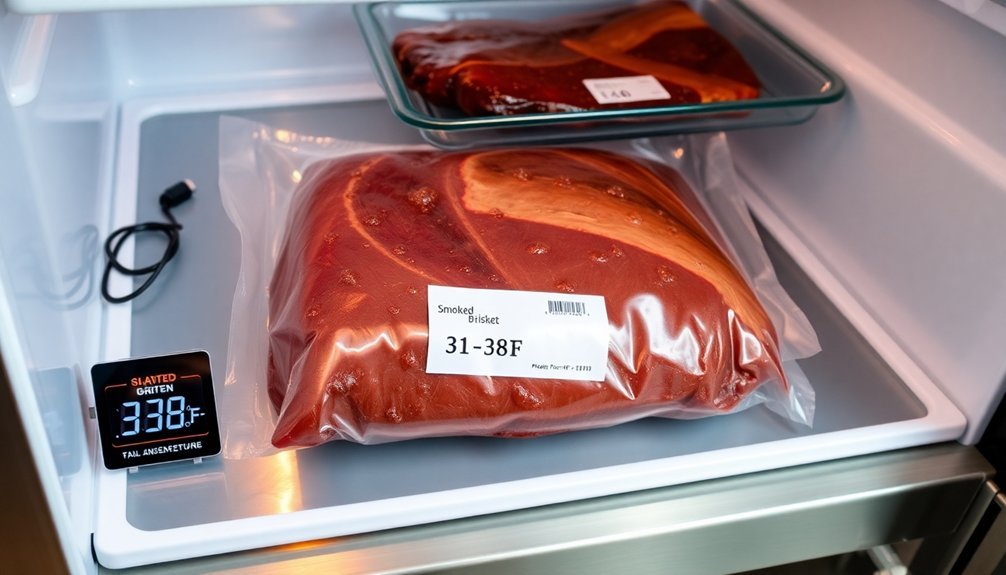
Proper thawing methods can make or break the safety and quality of your smoked meats. Your safest option is to thaw meat in the refrigerator, allowing 24 hours for every 5 pounds. You'll need to plan ahead, but this method maintains the meat's integrity and lets you safely refreeze if needed.
If you're short on time, you can use the cold water method. Place your meat in a leak-proof package and submerge it in cold water, changing the water every 30 minutes. A one-pound portion will thaw within an hour, while 3-4 pounds takes 2-3 hours. You'll need to cook the meat immediately after it's thawed.
For small portions, you can use your microwave, but be careful – it often creates hot spots and uneven thawing. You'll need to cook microwave-thawed meat right away to prevent bacterial growth.
Never leave your smoked meats out on the counter or in hot water, as temperatures between 40-140°F create ideal conditions for bacteria. Keep thawing meat on the bottom shelf of your refrigerator to prevent drips from contaminating other foods.
Airtight Container Selection
For the best protection of your smoked meats, selecting the right airtight container is vital. You'll want to choose containers that completely seal out air to prevent oxidation and spoilage. Glass or plastic containers with secure, tight-fitting lids are your best options, but make sure they're free from any cracks, chips, or signs of wear that could compromise their effectiveness.
Before storing your meat, verify your container is thoroughly clean and completely dry. You can enhance protection by first wrapping the meat in plastic wrap, followed by a layer of aluminum foil with tightly crimped edges. For extra moisture control, consider adding a layer of wax paper between the meat and the plastic wrap.
When placing your containers in the fridge, position them on the bottom shelf to prevent any potential drips from contaminating other foods. Keep the temperature between 34°F and 40°F, and don't overcrowd the storage area – proper air circulation is essential for maintaining consistent temperatures.
If your refrigerator has crisper drawers, you can use these for additional humidity control, but remember to check the humidity settings regularly to maintain ideal conditions.
Label and Date Everything
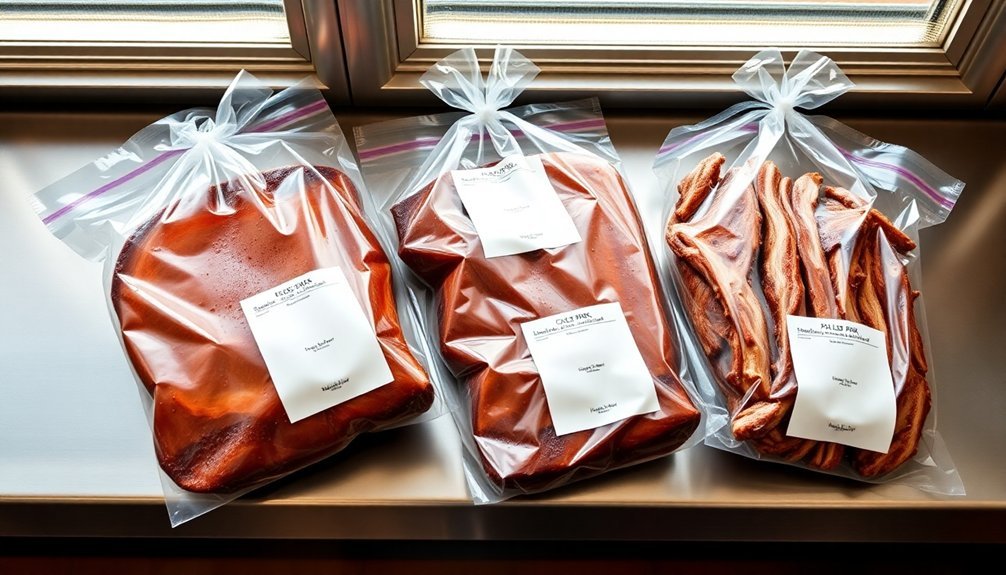
You'll need to clearly label your smoked meats with both the product name and packaging date to track freshness and prevent confusion about what's stored.
Proper labeling helps you monitor storage times, identify contents quickly, and guarantee you're following safe consumption guidelines according to the "best by" dates.
Writing storage instructions directly on the container's label will help you maintain ideal conditions and know when it's time to use or discard the meat.
Clear Labeling Best Practices
Clear and thorough labeling serves as the foundation for maintaining organized and safe smoked meat storage. When you're labeling your smoked meats, you'll need to include specific details that comply with safety standards while making it easy to track your products.
Start by clearly identifying the type of meat and its form – for instance, "Sliced Smoked Beef Brisket" or "Diced Smoked Pork Shoulder." You'll want to include the smoking date and storage date on each package. Don't forget to add handling instructions, including proper storage temperatures and reheating guidelines to prevent foodborne illness.
Create a consistent labeling system that includes:
- The exact cut and type of meat
- Date of smoking
- Storage date
- Expected "use by" date
- Storage temperature requirements
- Reheating instructions
- Any special ingredients or seasonings used
If you're storing multiple types of smoked meats, use different colored labels or markers to distinguish between varieties. This practice helps you quickly identify items and maintain proper rotation of your stored meats.
Remember to write legibly and place labels where they're easily visible, even in crowded storage spaces.
Why Dating Matters Most
Building upon proper labeling practices, dating your smoked meats stands as the most essential aspect of the entire preservation process. Without proper dating, you'll struggle to maintain food safety and effectively manage your inventory. You'll need to clearly mark both the smoking date and the recommended consumption timeline on each package or container.
Dating helps you implement a first-in-first-out system, making certain you're using older products before newer ones. This systematic approach prevents waste and maintains the quality of your smoked meats. When you properly date your items, you're better equipped to track how long each piece has been stored and can easily identify when it's time to consume or dispose of the meat.
You'll find that dating also plays a vital role in preventing foodborne illness. By monitoring storage duration through accurate dates, you can avoid consuming meat that's past its prime. Make sure you're including both the processing date and the "use by" date on your labels.
This double-dating system helps you maintain proper rotation and guarantees you're not keeping smoked meats beyond their safe storage period. Remember, even properly smoked meats have a finite shelf life.
Humidity Control Methods
Moisture management plays an essential role in smoking meat successfully, and there are several reliable methods to control humidity levels in your smoker. A water pan placed at the bottom of your smoker serves multiple purposes – it maintains consistent humidity, catches grease drippings to prevent flare-ups, and creates steam to keep your meat moist.
You'll get better results by using an oversized pan that increases the surface area for evaporation.
You can enhance moisture retention by spritzing your meat with apple cider during the smoking process or brining it beforehand in a salty-sweet mixture. When you're a few hours into smoking, wrap your meat in aluminum foil or butcher paper to lock in moisture.
If you prefer more smoke flavor, opt for butcher paper since it's more porous than foil.
Keep a close eye on your smoker's environment by monitoring temperature and airflow through the vents. You'll know you've achieved the right balance when you see thin blue smoke.
For additional humidity control, consider using tools like the Walton Smoker Soaker towel, which can boost relative humidity up to 47%.
Frequently Asked Questions
Can Smoked Meats Be Stored in a Wine Cellar?
You can store smoked meats in a wine cellar temporarily, but it's not preferable long-term since the temperature (50-60°F) is higher than recommended storage temps (below 40°F) for best meat preservation.
Does Freezing Smoked Meat Affect Its Smoky Flavor?
You won't lose the smoky flavor when you freeze your smoked meat. If you wrap it properly and freeze it quickly after smoking, the freezing process actually helps preserve those delicious smoky compounds.
How Long Can Smoked Meat Stay at Room Temperature?
You shouldn't leave smoked meat at room temperature for more than 2 hours. Beyond that, you're risking bacterial growth. If it's above 90°F (32°C), reduce that time to just 1 hour.
Should Different Types of Smoked Meats Be Stored Separately?
Yes, you'll want to store different types of smoked meats separately to prevent flavor transfer and maintain proper storage temperatures. Don't mix cold-smoked, hot-smoked, and dry-cured products, as they have different storage requirements.
Can I Add Herbs to Stored Smoked Meat to Enhance Flavor?
You shouldn't add herbs to already-stored smoked meat as it won't enhance flavor effectively. Instead, incorporate herbs during the smoking process or in dry rubs before smoking for the best flavor results.
In Summary
By following these storage methods, you'll maximize the shelf life of your smoked meats and maintain their delicious flavor. Remember, proper temperature control, vacuum sealing, and careful wrapping are your best allies. Don't forget to label everything and monitor storage times closely. When you're ready to enjoy your smoked meats again, you'll appreciate the time you took to store them correctly.





Leave a Reply